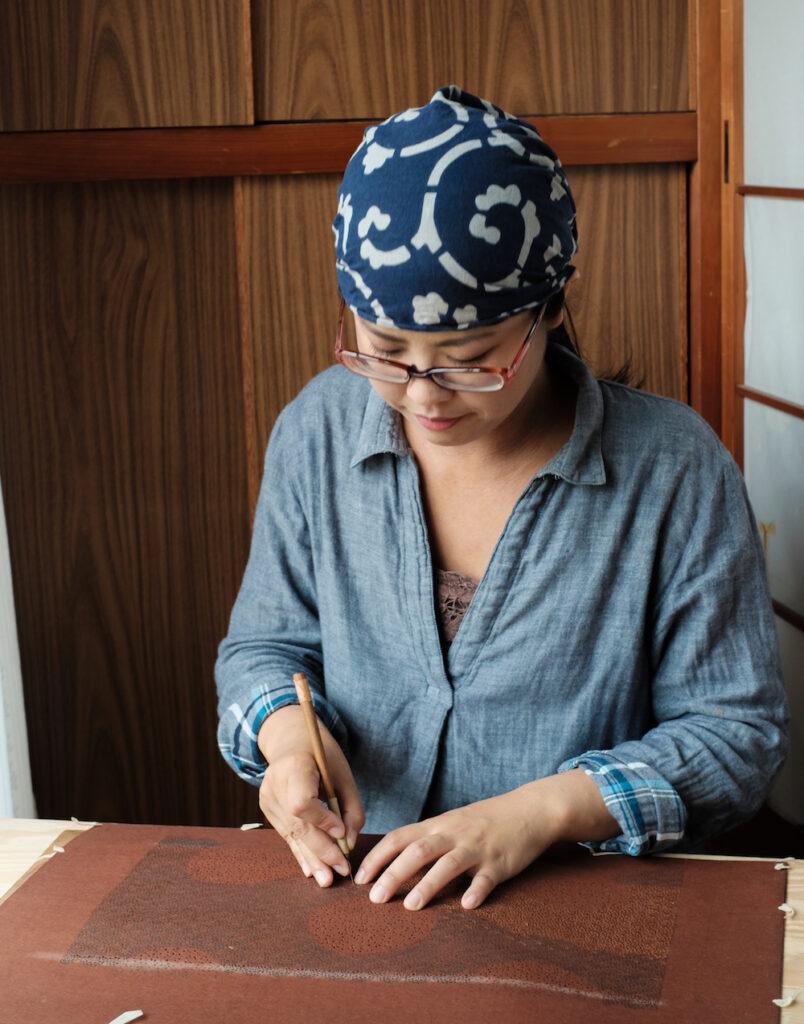What is Ise Katagami?

Even now, more than 90% of the patterns distributed in Japan are made in the Shiroko district of Suzuka city.
From around 1619, it received the generous protection of the Kishu domain and made dramatic progress.
The technique of digging out delicate patterns has been refined and has been handed down to the present day as an important tool for dyeing.
Feature
Apply persimmon astringency to tough and highly storable Mino Japanese paper, attach 3 to 4 sheets of fibers alternately in the vertical direction and in the horizontal direction so that the strength increases, apply persimmon astringency again and dry, first mold Make a base paper.
The patterns and patterns of the kimono are carefully carved into it, which becomes the pattern used when dyeing the fabric.
In 1983, it was designated as a national traditional craft (tool) under the name of “Ise Katagami”.
Technique
①Shima bori(縞彫:Striped carving)

Place a knife on the ruler and pull it toward you to carve a striped pattern.
For thin objects, 11 stripes may be carved in a width of 1 cm, which is a technique that is extremely focused.
It is called striped or drawn carving.
“Drawing” is originally a term that refers to the above-mentioned striped carving technique, but recently, the technique of pulling a knife to carve is widely called drawing.
②Tsuki bori(突彫:Carving)

Place the base paper on the hole plate, push the knife with a sharp edge vertically against the base paper and push it forward while moving it up and down, and use your other hand to carve while adjusting the carving opening It’s a technique.
There is a peculiar subtle shaking in the carved mouth (carved line), and you can really feel the “hydrangea” and “warmth” of hand carving.
③Dogu bori(道具彫:Tool carving)

Before carving, first make cutlery in the shape of petals, fans, rhombuses, horns, rice grains, geometric patterns, etc. It is a technique to carve out those molds with a single pick using the tool.
How to make good tools is a demanding task.
Complex patterns are carved evenly, and the variety of patterns is characteristic, and it developed from the late Edo period.
It is a technique that is indispensable for Komon patterns, and is also commonly called Gottori in Edo Komon.
④Kiri bori(錐彫:Gimlet carving)

It is a technique in which a semi-cylindrical blade is erected vertically on the base paper and rotated to make one round hole, and a handle is made only by the continuous or combination of large and small holes.
It is said to be the oldest technique for small patterns, and patterns such as sharks, manners, throughs, and arare are made with this technique.
It is said that some of the finer ones have about 100 holes carved in 1 cm square.
Even if you use a cone of the same size, the size of the hole will change depending on the amount of force applied, so the finished pattern is rather difficult because it is simple, and it is a technique that has a great deal of concentration.
⑤Itoire(糸入れ:Thread holder)

As for the pattern with few striped patterns and unengraved parts, the striped god is easy to move and unstable at the time of molding (dyeing), so a process called “thread insertion” is applied to fix it.
In that case, the pattern base paper is made in advance so that it can be easily peeled off into two sheets. After carving, it is peeled off into two sheets, and in the meantime, raw silk (silk thread) is applied laterally or diagonally to the stripes. Put a number of them together and stick them on the original one with a suitable sticky persimmon astringent.
Two sheets of paper with a finely carved pattern are pasted together on one sheet, which requires a great deal of effort and skill.
Working process
①Kami-tashi to Hodukuri(紙断ちと法造り:Paper cutting and law making)

Cut handmade Japanese paper to the planned dimensions (cut the paper) and make a set of 3 or 4 sheets.
Assemble the fibers alternately vertically and horizontally so that there is no uneven thickness. (Law making)
②Kami-tsuke(紙つけ:Paper)

Use a brush to attach a set of 3 pieces of Japanese paper to a “paper plate” that is hung diagonally.
When the pair has been pasted together, make a fold mark on the corner and stack dozens of sheets on top of it in the same way.
After finishing the paper, let it sit for 2-3 days and wait for the persimmon astringency to penetrate sufficiently.
The resulting paper is called raw paper. (It is in a damp state with persimmon astringency)
③Kigami-hari(生紙貼り:Paste raw paper)

Using a brush made of straw, stick the raw paper on the paper-covered board.
For small size paper, stick 2 sheets (2 sets) on one side, and for large ones (1 set).
④Kanso 1st time(Tenpi-boshi)(乾燥 1回目(天日干し):First drying (sun-dried))

Dry the entire paper board in the sun.
If it is a sunny day, it will dry in 2 to 3 hours.
After drying, remove it from the board.
Avoid exposure to rain while drying in the sun.
⑤Kami-yori(紙選り:Paper selection)
Paper dust (mixed, adhered to the direction) is removed with a kitchen knife and sorted.
⑥Muro-ire 1st time(Muro-karasi)(室入れ 1回目(室枯らし):First room entry (room withering))

Place the sorted paper in a smoking room (room: Muro) and smoke it with sawdust from Japanese wood (pine, cedar, cypress) throughout the day and night on the 7th to 10th.
By withering, the paper becomes even less stretchable and is reinforced with smoke tar.
Around 1877 (Meiji 10), until this “Muro-Kai” was invented, it was left in a low humidity place for about half a year to die naturally.
⑦Shibu-ire(渋入れ:Astringent)
Soak the paper out of the room in persimmon tannin for 1-2 hours and reattach it to the board.
⑧Kanso 2nd time(乾燥 2回目:Second drying)

Repeat the process from sun drying to room withering.
It takes more than 40 days from papering to here.
⑨Senbetsu to houchi(選別と放置:Sorting and neglect)
After sorting the finished paper, let it sit for a few months to a year to stabilize its dimensions.
Traditional craftsman
Horishi(Tattooist): Keiko Nasu

Hope, a young man in the Ise katagami world, where craftsmen also look forward to the future.
I feel the potential of the future in the attitude of working persistently in the production area.
Originally I worked for a printing company, and I had to cut paper and draw pictures, and that time was always immersive and fun.
When I quit the company, I thought that it would be better to have a more manual work, and I thought, “If you are a traditional craftsman, you can immerse yourself in the work by hand,” and while investigating various manufacturing. I met at.
When I actually started working as a craftsman and thought that I would just work silently, I also needed a job to increase demand at the same time.
The foundation of Ise katagami is carving technology.
On top of that, there is a unique design and texture after dyeing, so I try to appeal the charm that Ise katagami can bring out.
Currently, a group called “Tokowaka” is also engaged in activities to increase technology and demand by working hard with young people.
Initiatives

There is a group of young craftsmen who are in charge of traditional crafts called “Tsunewaka”, which is active mainly in Mie prefecture.
Not only for the purpose of exchanging techniques possessed by craftsmen of Ise netsuke, Ise katagami, Ise sword carving, and lacquer art, and sharing worries with the same generation, but also an opportunity for many people to know traditional crafts. It was launched in 2012 with the hope of becoming an activity.
By telling many people that traditional crafts are wonderful, as many people as possible will appear in the lost traditional crafts, and by letting them know the charm of traditional crafts, traditional crafts We are working with the desire to increase the number of people who use.
The appeal of young craftsmen is that they can challenge various things without setting restrictions.
The spirit of “Tsunewaka” is “Let’s inherit the unchanging spirit of traditional crafts and create traditional crafts that suit new times.”
How was your trip this time?

I thought it was a technique that you can see the delicacy.
If you just make a paper pattern in modern society, the opportunity is very easy, and it will make a beautiful work without any deviation.
However, there is no pattern that looks the same, and there is no pattern that is the same, and since the soul of the craftsman lives in it, the pattern that is carved by human hands will really move people’s hearts.
I thought that tradition should not be inherited because it has tradition, but it should be inherited and further evolved because it is a technology that is needed in the world.
As I got to know the people involved in traditional crafts, I reaffirmed from the bottom of my heart that I would like to come into contact with traditional crafts and convey the “Kokoro(心:heart)” of traditional crafts to as many people as possible.
I briefly introduced what it is like, but when you actually come to the site, you will be asked to experience the history and traditions more concretely with the local people.
We look forward to guiding you in Japan!
Thank you for reading to the end!
Also, I would like to post an interesting part of Kansai.
Then, have a good trip from now on!!
PS. We provide various information about Kansai in Japan, so please feel free to contact us if you would like to directly observe and experience Japanese traditional culture and food culture!
The content of the homepage is limited to Nara Prefecture, but if there is a place you would like to visit, please contact us and we will guide you!
Let’s find your own happiness together!!




コメント